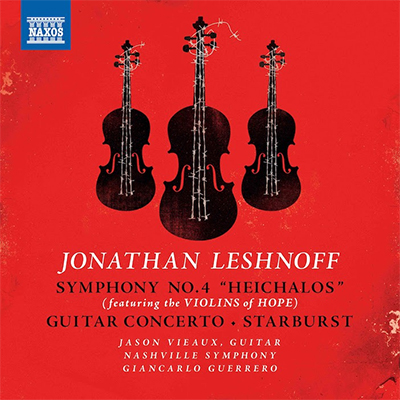by Hannah Schoepe

The concerto was commissioned by the Baltimore Symphony, in part due to Leshnoff’s frequent collaborations with conductor Marin Alsop. The Nashville Symphony, Reno Philharmonic, and Orquesta Sinfónica del Principado de Asturias co-commissioned the work.
Although Leshnoff has extensively explored concerto form throughout his career, he was surprised when asked to write a concerto for guitar. In the liner notes he wrote, “I never could have predicted I’d take on that challenge. I don’t play guitar myself, and it’s notoriously difficult to write for the instrument unless you play it.” Balance, as one can imagine, is notably tricky between orchestra and guitar. Addressing this issue right away, Leshnoff continues by saying, “Every instrument has a few blackout zones where it won’t be heard with an orchestra playing alongside it, but with guitar you have to be incredibly careful across the whole range.” His thoughtfulness in this area has been invaluable, because the balance throughout the album is a remarkable achievement. The guitar is never overpowered by the orchestra, and harmonizes beautifully with the orchestra’s vast landscape of supporting melodies.
With a majestic opening, the first movement showcases the guitar in a highly virtuosic light. Between the three movements, the first has the most traditional form, with a dramatic, cadenza-like opening, and a bouncy secondary theme. A certain element of groove is present throughout, putting the listener in an upbeat state of mind from the beginning. The orchestra builds tension with continuously ascending lines that come to a magical resolution in the middle of the movement. The ending is spirited, crescendoing into silence.
The album as a whole, including the Concerto, celebrates Jewish spiritualism. This is especially apparent in the second movement, which presents a metaphorical connection between the music and the Jewish concept of hod, or humility. In Jewish thought, hod describes the awareness of one’s smallness in the universe and an appreciation of others. This is also shown by the orchestration, which is reduced to violins, harp, and percussion. Vieaux plays the lyrical lines throughout this movement with a genuine sense of contemplation and heartfelt emotion.
Locomotion seems to be the theme of the third movement, which starts with an astringent triplet motive, creating an edgy, front-of-the-beat sensation throughout. In the middle of the movement there is a little surprise in the form of a violin solo, providing further drive. As tension builds, the rhythmic motive becomes an ostinato that Vieaux strums in constant repetition. The energy cascades to the very end, building up with rousing rhythmic energy.
The work is a joy for the listener, and quite possibly, as Nashville Symphony conductor Guerrero says, “One of the greatest additions to the guitar and orchestra repertoire in recent years.”
Also included on the CD is Leshnoff’s Symphony No. 4, “Heichalos,” featuring the Violins of Hope, and Starburst. The album is available via Spotify, Naxos, and Amazon.
Published on ClevelandClassical.com December 12, 2019.
Click here for a printable copy of this article



